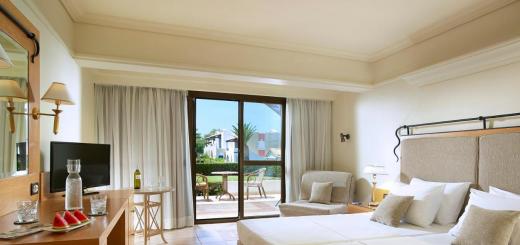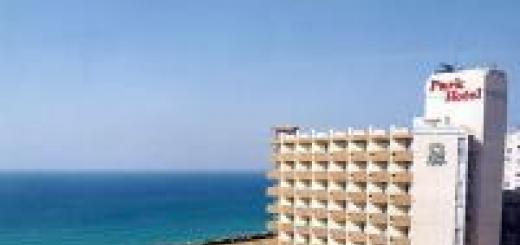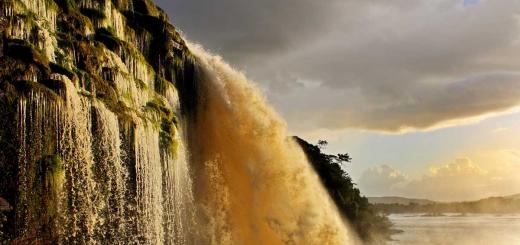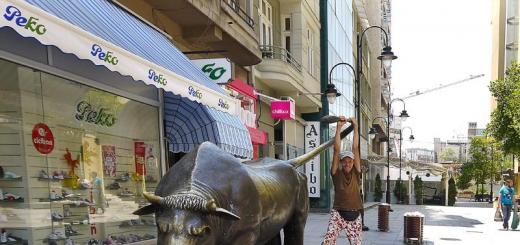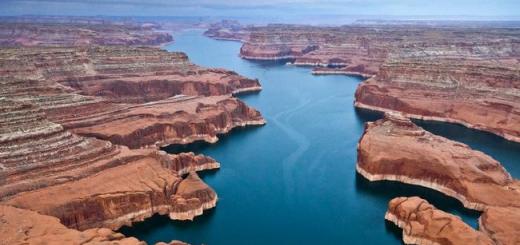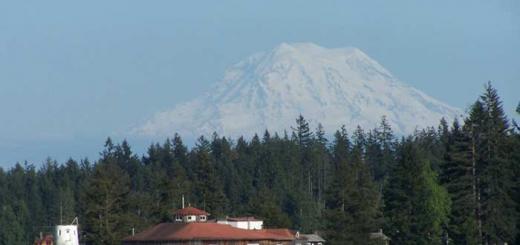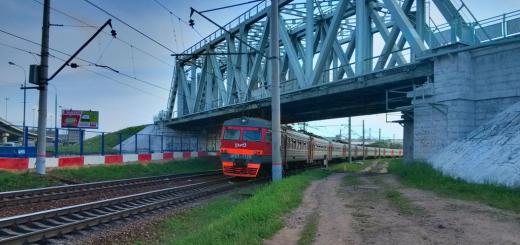Mezmay - unique place attracting to itself. People from all over Russia come here forever. Some feel cosmic energy here, because it is not for nothing that psychics come here, calling Mezmay " anomalous zone"and even" Russian Shambhala. " beautiful nature, creative people get their inspiration here. Dozens of interesting tourist routes... I'll tell you about one of them.
Mezmay is translated from Adyghe as "forest of wild apples". It was originally founded as a village for woodcutters and gold miners. Currently, it is a mountain tourist village in the Absheron region. Krasnodar Territory... Once there was a narrow-gauge railway connecting the village with the rest of the world. Now the operating section of the narrow-gauge railway remains in the neighboring village of Guamka. Until recently, a bad road led to Mezmay, but now the asphalt has been laid to the end and it has become easier to get there. The village is located 180 km from Krasnodar.
Despite the fact that many tourists from all over Russia constantly come to Mezmai, a regular bus still does not go here. They say that only Kamaz drives once a day, and even then not every day. Therefore, the easiest way to get here is by car.
In the vicinity of Mezmay there is a very interesting Mount Matuk, the story will go about her. Its height is almost 2000 m, it is located only 14 km from the village. That the road here is well-trodden and wide, and you can even climb the mountain in a good SUV. But we are not jeepers, so we walked to the top on foot. Climbing the mountain is difficult for one day, so we took two days. On the first day we settled on Ivanova glade, where there is a spring and beautiful views, they also ran to Mount Zaudu, but there is nothing to do there in the summer, because the panorama is not visible from the tall grass, it is better to do this in May.
Matuk is a part of the Lagonaki ridge and borders on the Caucasian reserve, so you don't need to buy a ticket to the reserve, and there are no checkpoints. At the very top we saw a herd of horses and a shepherd, but it is possible that huntsmen can walk here and collect wages.
2. The road to the Matuk mountain is not difficult, even children can master it, but you need to understand that a 14 km hike is equal to 28 km on a regular flat road. 
3. There are many mountain flowers on the top of the mountain. There are almost no trees, only endless green meadows. 
4. Picture from Windows. 
5.
6.
7.
8. From Ivanova Polyana to Matuk Mountain to go 8 km, actually got there quickly. The first peak we saw - Mount Nagoy-Chuk (2467 m), is already in the reserve. 
9. This is how the Lagonaki ridge looks like on which our mountain is located. 
10.
11. We were at the end of July, the weather is fine. 
12.
13.
14.
15.
16.
17.
18. These rocks are called "Two-storey building". 
19.
20. From the Matuk mountain, beautiful panoramas open on the Lago-Naki plateau, you can see the Oshten, Pshekha-Su, Nagoi-Chuk mountains, the gorge of the Tsice river and others. 
21.
22.
23. From here you can clearly see Mount Oshten (2800 m). 
24.
25.
26.
27.
28.
29.
Based on the book by I.V. Bormotov.
We decided to plunge into the purple and gold of early autumn not in the usual way, throwing our backpacks over ourselves and forward, but to sit on dashing jeeps and race along the mountainous terrain. The route was chosen as follows: Maykop - Dagestanskaya - Red Dagestan - Nizhegorodskaya - Guamka - traverse on jeeps of the Lagonak ridge with heights: Lysaya -1159m, Matazyk -1328m., Razvitaya - 1514m., Letter -1706m., Zhitnaya - 1997m., Matuk -1957 , 6m. Mezmay -1939.6 m and Abadzesh -2369m.
Arriving in Guamca, we were amazed at what we saw. There was nowhere for the apple to fall on the road transport site. There were more than a dozen painted jeeps and the same number of ATVs offering tourists a ride through the high-mountainous zone of Adygea, to Mount Zhitnaya. Most of all we were impressed by the "huge" jeep made on the basis of the GAZ-66. A luxury salon from a simple jeep was attached to the large wheels.
Traditionally, we visited the local souvenir market, walked several hundred meters along the sleepers railroad, admired the sheer walls of the Guam Gorge and frankly admired the amazing beauty of the stone creation.
Guamka comes from the Adyghe word Guame. It means smell. In spring and early summer, the humid, shady gorge is filled with the tart aroma of a flowering caper, and in the fall with the pungent smell of a serpentine worm-kitty. The pleasant, enchanting aroma of the gorge changes every time depending on the prevalence of wild plants, linden, azalea or mountain jasmine blooming in it. This incomparable aroma, noticed by the Circassians hundreds of years ago, gave the name to the ridge, gorge and a small village of woodcutters.
How many beautiful and poetic words have been said about the amazing beauty of the Guam Gorge, we are also delighted with this earthly miracle.
Guam Gorge is an amazing natural monument, striking in its magnificence, abundance of minerals and variety of vegetation.
If you are lucky enough to get into the Guam Gorge, then, closing your eyes deeply and freely breathe in with pleasure, you will immediately feel the tart taste of real mountain air coming from the Lagonaki Highlands and infused with flowering herbs that grow in the Guam Gorge itself.
Look attentively at the blue autumn sky, the sheer rock walls, and you will see the true uniqueness of the Guam Gorge, in the delightful colors of the mountain layers.
Multi-colored rocks: from grayish-blue, yellow-red, lead-black to whitish-smoky colors. In the depths of this fabulous break in the earth's crust, as in an amazing artist's studio, nature creates every day and surprises with an unimaginable range of vibrant colors, tones and halftones under different angles of sunlight.
The rock walls of the Guam Canyon belong to the limestones of the Upper Jurassic period. Sedimentary rocks are deposited in layers and they are all different colors. And the secret of the color of the layers is explained by the fact that at the bottom of the Upper Jurassic sea, where limestones were deposited, at different times, depending on the changed conditions, the composition of the dyes - organic and inorganic compounds - also changed.
Touch your palms to the rocks polished over millions of years and feel how your body is filled with strength, health and the divine natural energy of the mountains.
Guamka - a small village of woodcutters in a short period of time has become a center of pilgrimage for excursion groups. Every year the number of people wishing to see this wonder of the world is increasing.
After talking with mountain "jeepers" and receiving advice from them on the planned route, we set out. The road, carved into the rocks, ascended a narrow steep serpentine to a drip waterfall called "Men's Tears". After driving several tens of meters from it, we stopped at the edge of a bottomless abyss. This is a famous observation point called "Cockerel".
Before us, in all its glory, an amazing panorama of the valley of the Kurdzhips river unfolded. The houses of the Guamka village are located deep below. Nearby, bathing in the rays of the sun and shimmering with glare, the water ripple of the Kurdzhips River sparkled. Near the tourist hotel, which looked like an old castle, tourists scurried about in small dots. Somewhere out there, in the distant wavy haze, among the sea of the forest, the city of Maykop disappeared.
Enchanted great view, on a quiet sunny day, without breeze and light movement of air, we froze in admiration. Yes! There is something in the mountains that bewitches the soul, makes the heart beat tremblingly and conquers us forever. Getting drunk from the mountain air and free soaring of the soul, we felt how our bodies are filled with the sweet nectar of the beautiful, how the thirst to see the real charm of the mountains is gradually quenched.
We look at the inhabitants of Guamka from the height of the flight of birds and understand what a happiness it is to live in the mountains, every day to fill our chest with the honey aroma of the intoxicating Lagonaki air and listen to the rustle of the foliage of the Caucasian forests.
Here below the forests have not yet been touched by the autumn fire of wilting. But the dark ruby blanket of fallen dogwood fruits, amber placers of wild apples, the delicate wine color of curly viburnums, and the chocolate shine of overripe forest pears are already talking about autumn.
The higher the mountains, the more noticeably the composition of the forest changes. Dark green boxwood forests give way to maple and beech trees interspersed with fir. Here, a quiet, brooding forest has just begun to dazzle with autumn gilding. A light flying breeze, gently blows, caresses the trees, picks branches, rustles and plays with leaves, creates that quiet magical music of farewell to foliage, which is so pleasant and desired by them alone.
But here is a vast clearing with an obelisk to the partisan detachment named after. Gastello. Behind the clearing, a stony gravel road descends into a small clay gully. It's time to confirm the status of all-terrain vehicles to the jeeps. Having connected the front axles, skidding and fanning mud on the sides, the jeeps confidently overcame the obstacle.
Escaping from the thorny Caucasian forests, we found ourselves on the alpine meadows of the Lagonaki ridge, which were hidden from us by the milky blanket of morning fog. The deep ravine was wrapped in the feathery veil of a sugar cloud. The damp morning coolness rose from a deep gorge with a barely perceptible movement of air, giving hope for good weather... A swarm of small cold raindrops flew from the high heavens and sprinkled us with crystal beads.
Moving in a foggy cloud along the Lagonaki ridge, we came across a herd of horses peacefully grazing in the meadow. Nearby was a shepherd's cat and a spring. I immediately wanted to drink pure spring water. After all, nothing for a person is more pleasant and tastier in this world than spring water. We gladly touched our lips to the purest unclouded surface of the crystal water of the spring.
Silk threads of sunbeams pierced the gray mantle of fog and descended on our lawn. Through the gap in the fog, a bright light showed the autumn blue of the sky. The radiant crystal light of her purity expanded, freeing the top of Mount Zhitnaya from the fog.
The vast alpine slopes of the northern exposure opened before us. So that's why it is planned to open a ski resort here! At almost 2000 meters above sea level, there are beautiful ski slopes, with good rollouts. A paradise for skiers. And this part of the Lagonaki Upland does not belong to the Caucasian Biosphere Reserve. On a busy mountain road A column of quads appeared on the Lagonaki ridge. Tourists traveling on this miracle of technology have a route to beautiful lake Lagonaki highlands, located in the northern circus of Oshten - Lake Oshten.
With delight, admiring the delightful views of the mountains, we slowly climb one of the peaks of the Lagonaki ridge, located between the Matuk and Zhitnaya mountains, and freeze with admiration. An amazingly beautiful country of mountains opened before us. A gigantic crown of thorns, sharp bared teeth, a shark rose from the sea of the forest, a beautiful rocky citadel.
A deep stone gorge, like a giant sea shell, opened its magic doors and presented before us the canyon of the Tsice River shining with eternal snows. This completely wild unbridled shrine of the Lagonaki plateau, the royal pearl of Adygea, amazed us with its beauty.
In a shining crown high mountains: Uriel, Abadzesh and Nagoy-Chuk, the gray-headed Oshten towered as a giant giant. In the strange land of rocks, in gloomy completely wild gorges, chamois and bears have settled down. Fir and pine trees, clinging to the rocks in chains, crawl upward. Giant talus covered the slopes with gray sheets.
At such moments, we are stunned by the beauty of the mountains, blissful and dreamy. The eyes of my friends shine with sparks and spread the light of the soul, burning with delight! These are the routes of my simple happiness! These are the castles of my dreams in the air!
Hello mountains and forest! - I shout and it seems to me that they also greet me. The trees rustled with leaves at once, the alpine grasses nodded merrily to me with their flowers, and the wind, coming from somewhere above, suddenly ruffled my hair and disappeared into the forest, happily rumbling with dry branches and playing a playful overture known to him alone.
I slowly descend under the rocky wall of the ridge and comfortably sit under a spreading pine tree, in a green velvet cushion of moss. In front of me, in the zone of the maple forest, trails of purple robes splashed out autumn. Unhurriedly, the majestic plane trees tried on a colorful gypsy outfit, white-faced birch trees dressed in festive dresses. The upper and lower canyon of the Tsice River is clearly visible from here. In some places, at the very bottom of the gorge, the surface of the Tsice River glitters like sunbeams. Here it is my cherished place warmed by my soul. And nothing else is needed. So I would sit and absorb this divine beauty of the mountains with every cell. And in addition to the amazing beauty of the mountains, there must be a lot of eagles circling in a round dance. But no, I peer into the blue of the sky and I see these are not eagles, but long-necked storks. Where are they from here in the mountains?
What happiness when there is an opportunity to be alone with nature, to observe its measured life, to feel like a particle of this mysterious world... And then you begin to feel how its invisible, magical and healing rays penetrate deep into the heart and heal the excruciating pain in the soul that has appeared from the empty soulless life of a modern city.
How short an autumn day! Already the mountains, engulfed in the fiery flame of the sunset, blazed with a delightfully solemn bright light. This makes them seem even higher, more triumphant, as if at last, in order to surprise us once again, Mother Nature spilled molten copper on the slopes of Oshten. And from this bright crimson fire the whole sky flared up and blazed. Throwing holiday fireworks all the way to space.
Gennady Zavada
SONG ABOUT "SOON"
Long live the sky above!
Long live the mountains in the distance blue!
Native rapids, clatter of wheels,
Steep roads and the bitterness of parting.
Hand-drawn croc, twisted path,
A babbling stream I follow you.
The gorge keeps deep secrets,
Not dripping above us, burning above us ...
Long live the sun, let the darkness hide!
Long live summer, and even winter! ..
Long live the heaviness of strained shoulders
Accidental joy of accidental meetings,
The smile of a beloved is a hopeful sister,
Fire from the fireplace, smoke from the fire.
Friends of tara-bars, a star in the air,
Guitar chords, tents in the woods! ..
I am happy, I am the one who went through all this! ..
And all because I searched and found.
We believe that our dreams will come true.
Long live I, and long live you!
Away from controversy, to an unknown land,
An ambulance takes us away: Guamka - Mezmay.
Last weekend the multisport club "Radio Cheget" opened new season from the so-called snowshoeing, which is self-evidently deciphered as a winter hike in snowshoes. All three days were perfect sunny weather.
True, having announced this event in advance and prepared for it, I felt a pre-cold ailment before the departure, but I did not cancel anything, which nevertheless made it possible to implement my plan, albeit on a different scale.
There were 9 participants in total. We started in the Guamka farm and went up the road to the Cold Spring. At first there was not much snow, only on the shady northern sections of the road the snow was solid.
And at first we walked in the footsteps of bold cars without snowshoes at all.
It was warm enough on the rise, I had to unbutton my clothes, undress, or, like in this photo, help each other unbutton the ventilation in the sleeve of the jacket :)
A small waterfall over Guamka is frozen over.
Well, how small ... so normal.
A short rest.
We walked along the track for the first hour, then we still had to put on snowshoes, because that day no one went further and we went on virgin soil.
The forest gradually became more coniferous and more snowy.
At this moment, I begin to realize that my cold is starting to progress dramatically and the pace of the entire trip has slowed down somewhat, but nevertheless, we succeeded.
After the Cold Spring we turned higher - on the portage leading down the Razrytaya Mountain, the snow was getting more.
And the sunset sun accompanied us.
First parking lot.
The snow was about knee-deep in open places, although there were also patches without snow under especially dense fir trees.
There was plenty of snow in the open glades.
On the second day, we continued our ascent to the border of the forest in order to go out into the open alpine meadows, or rather in this moment to endless snow fields :)
So, the fir ended, the forest thinned out. The views began to open up. Behind our backs, somewhere far below, the Guam Gorge and the village of Nizhegorodskaya.
The top of the Razrytaya mountain. At the bottom left in the valley - the village of Chernigovskoe.
On the horizon is a panorama of the mountains, traditional for this region (from left to right) - Bolshoi Tkhach, Maly Tkhach, Asbestnaya, Acheshbok, ridge. Skirda, Dzyuvia town (Solontsovy ridge).
We climbed to the pass between Bukva and Zhitnaya.
Our goal is Mount Zhitnaya. Our route goes along the so-called Lagonaki ridge, but this ridge has no direct relation to the Lagonaki plateau, starting much further north, almost from the village of Chernigovskaya (although in the end it adjoins the plateau with a strong decline after Mount Mezmay).
Part of the group remained at the pass, sheltering from the wind on a heated patch under the rock.
The rest went radially (without backpacks) to the highest point of this ridge - Mount Zhitnaya. In time, we only managed to climb there radially, and immediately we had to go down into the forest in order to organize the next overnight stay.
A group on the ridge of Zhitnaya.
And on her pre-summit shoulder.
On the pass, as in any other "ventilated" areas - there is not as much snow as it should have been in winter at such an altitude. It is "blown out" by the wind.
We go downstairs.
In the cold evening shade, but in the forest, where you can make a fire and generally warmer at night than in open spaces.
There is the most snow here on the northern slopes of Zhitnaya. If not for the snowshoes, it would have been possible to fall through to the waist.
We quickly dropped about 500 meters in height and stopped for the night in a more or less gentle place by the road, so that the next day we could get to civilization faster.
I didn’t take pictures of the overnight stay that day, because of indisposition I preferred to sleep through breakfast, and then, on the contrary, to get together before everyone else and go forward slowly so as not to delay the others. Here's a single random shot.
On the way back, we noticed how much the amount of snow had decreased, especially in those places where all kinds of transport rolled it out. And if on February 21 the glade near the Cold Spring was with untouched virgin snow, then two days later it was rolled into mud (fu!) By a bunch of ATVs, and then several SUVs.
The photo shows the Monakhova Cave on the opposite slope of the Guam Gorge.
Initially wanted to do big ring, having returned through Mezmay, but because of the low rate and wet snow, we had to return to Guamka almost the same way as we started.
35. Track here - http://caucasia.ru/site/track/1160 (without climbing Zhitnaya).
Latitude: 44 ° 12′13′08′70 ′ ′ ′ N
Longitude: 39 ° 91′49′74′01 ′ ′ ′ E
Lagonaki ridge- a mountain range located near the Lago-Naki plateau (Maikop district, the Republic of Adygea), stretching from north-west to south-east for almost 17 km. The territorial border between the Republic of Adygea and the region of the Mezmaysky rural settlement of the Apsheronsky region of the Krasnodar Territory passes through the crest of the ridge. Also, the territories of the Caucasian State Natural Biosphere Reserve and the object of the World natural heritage « Western Caucasus". Most of the Lagonaki Ridge is lined with a grass carpet, which contains a variety of endemic species of flowers, among the thickets of which you can find running lizards. Broad-winged birds soar in the sky: bearded vultures, vultures, kites.
The Lagonaki Ridge includes smooth domed peaks such as: Lysaya(1159m), city of Matazyk(1328m), dug(1514m), G. Letter, Zhitnaya(the most high point ridge / there are also names such as "Tour" and "Sharp"), Matuk, Mezmay... Fantastic panoramas open up from each mountain top.
Mountain Letter (1700m) - located 12 km from the Guamka farm. On all sides of the summit, there are wooded valleys spread out in the lower reaches. In the western part, the slopes of the Letter plunge down steeply, and the lower canyon stretches two kilometers from the foot. Tsitsa river... V southbound one more hillock is visible (1724m), which has not yet received official name, but probably already somehow nicknamed local residents... Just like the Letter, western wall strewn with stony outcrops. To the south and southeast, there are imposing subalpine fields, which sharply turn into the forest zone. Mountain tributary Kurdzhips river – Dry beam- flows a little to the east, behind its bed rises Mount Zauda(1539m), located near an unremarkable Ivanova Polyana... Next to the Letter there is a shepherd's booth.
2.3 km south of the Letter is located Mount Zhitnaya (1996m), from the slopes of which you can see more fascinating views. The most interesting is the overview of the steep gorge of the upper reaches of the Tsice River, which is a Natural Monument. The gorge is backed by massive walls ridge Nagoy-Chuk on the one hand, and the steep slopes of the Lagonaki ridge on the other. A waterfall breaks out of the sheer wall of the Nagoichuksky massif, and there is no way to approach it. There is a small cave in Mount Zhitnaya, and a few meters from it there is observation deck and right there, in the direction of the Tsitsinsky channel, a small brook leaves.
Between the mountains Zhitnaya and Matuk rises a small wooden structure called "KOSH", such structures can be found very often on the routes. As Wikipedia suggests, kosh are the auls that are found on the way during nomadism, as well as in kosh, with the onset of spring, wealthy Bashkirs lived. Such structures were built on spacious meadows, where it is very convenient to look after the grazing cattle.
The alpine house is knocked together from wooden boards covered with a felt cloth. As a rule, inside the booth there is a stove, two-tier shelves and a table. A tourist group from 10 people can fit inside. Near the kosh, under Mount Zhitnaya, the Sukhoi Balka stream flows.
Before reaching the cliff of the two-story building, there is another spring - Cement (or Concrete)... It was built by German fascists during the Great Patriotic War, and to this day, it has been preserved, although it has already been a little worn out.
Two-story building - a gentle rocky ledge of the foot Matuk mountains(1957m). The surface is perfectly flat and covered, like a terry green carpet. The perpendicular rock walls consist of two levels of almost the same size, which is probably why the two-storey rock was nicknamed. On the platform of the two-story building, magnificent panoramic views are presented to the gaze. The grandiose gorge of the Tsice River, surrounded by fir and boulders, is barely visible in the distance. But the sound of water is clearly audible, created by the turbulent current of the mountain river Tsitsa, rushing from the northern slope of Mount Oshten, which is also observed behind the Tsitsinsky canyon. At the very cliff of the Matukskaya Two-storey building, the right tributary of the Tsitsa River - Glubokaya gully (the source is the southeastern slopes of Mount Uriel / Murzikal tract) is clearly visible. Near its channel there are two Mezmay caves (cave of the Six / Six). In the southeast, the hilly ridge Nagoy-Chuk stands out, a little to the left of it gracefully carved stone walls Uriel mountains descending to the valley of the Tsice river.
The final peak of the Lagonaki ridge is Mount Mezmay(1940m), located 15 km from the village of Mezmay. In the eastern part of the mountain there is KOSH, next to it is a spring with clean drinking water. A stunning view of the Kurdizhps river valley opens from the cliff (source - Mount Abadzesh), which cut beautiful gorges and gorges in the rock massifs (Guam Gorge). In the southwest flows one of the tributaries of the Tsice River - Deep beam, there is also a convenient site for camp. On the opposite side, there is another stream hiding, rushing towards the Kurdzhips river bed. The saddle between the Mezmay and Uriel mountains forms ravines steeply descending to the valley of the Tsice river, allowing you to get to the Tsitsinsky canyon. Domesticated cows and horses are common in the alpine meadow.
Climate... The mountainous area has very tricky weather conditions. It is here, in the mountains, that you can observe the process of the water cycle in nature. In the morning, as a rule, the weather is clear, but when the first clouds begin to pour in, it will be raining. In the evening, usually bad weather passes, allowing you to admire the beautiful sunset.
A road has already formed up to the Dvuhstazhka cliff, allowing reckless drivers to sweep along the Lagonaki ridge in cars. In general, it is strange why this is allowed ...
It is on its territory that Mount Zhitnaya rises. But first things first. In the village of Guamka there is a tourist site, where those who want to see the heights of Adygea, including the peak of Zhitnaya, gather with their own eyes. From here, jeeps depart, which take people along the serpentine to mountain peaks... At the peak of tourist activity, a whole parking lot operates on the site.

The name of the Guamka gorge comes from the word smell, and indeed, depending on the season, this place is full of different scents. It is truly a natural monument that never ceases to amaze with its beauty and grandeur. From this gorge, the road leads along a serpentine lined in the rocks. It rises like a ribbon to the "Men's Tears" waterfall. A little further behind it is the observation deck "Petushok".
From it we can see the amazing landscape of the Kurdzhips river valley. Water surface and forests, behind which is Maykop. Standing at such a height and breathing in the mountain air, you feel unusually free and light. Moving further along the ridge, you find yourself in the meadows. Here you can stumble upon horses grazing peacefully, which fit so organically into the general landscape. The variety of flowers and herbs is comparable only to the meadows of the Alps. And now, before the gaze of a tourist, she is exposed, the top of Mount Zhitnaya.

More than 2000 meters above sea level, a great place to organize ski resort... The rolled-out slopes will delight any connoisseur of alpine skiing. If you come closer and find yourself between the Zhitnaya and Matuk peaks, you can see the Lagonaki ridge in all its glory. Here, in the gorge, there is a canyon of the Tsice River, which is one of the visiting cards of these places. It is hidden from prying eyes, but pleases those who were able to climb so far. So wild and unexplored, it glows with natural beauty.
Among all the peaks of the ridge is Oshten, who seems to be the eldest in this family. In its gray peaks, among the firs and pines, bears and chamois have found refuge. Nearby there are peaks Uriel, Abadzesh and Nagoy-Chuk.
Standing in such beauty, you forget about everything in the world, you want to scream, breathe that mountain freedom that is in the air. Moreover, you want to come to these surroundings at any time of the year. Autumn will greet travelers with golden maples, winter will enchant with snow-white landscapes, spring will delight the awakening nature, and in summer the greenery of flowers and trees will not leave you indifferent.
It is true that the mountains always have their own atmosphere, some special calmness envelops these places and you want to come back here again and again.

